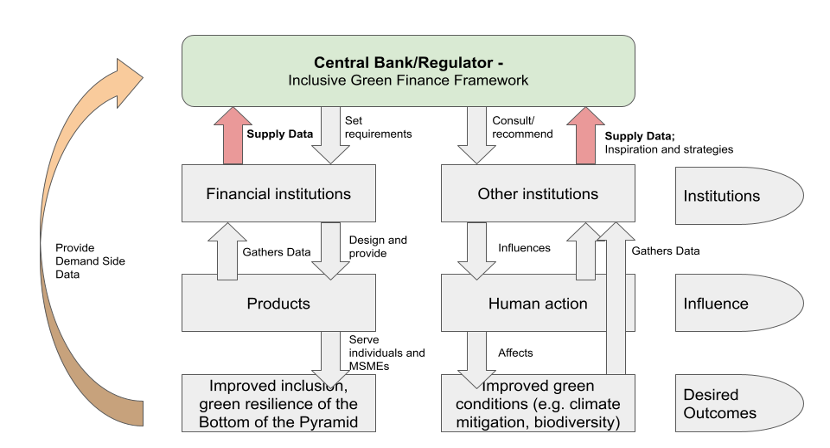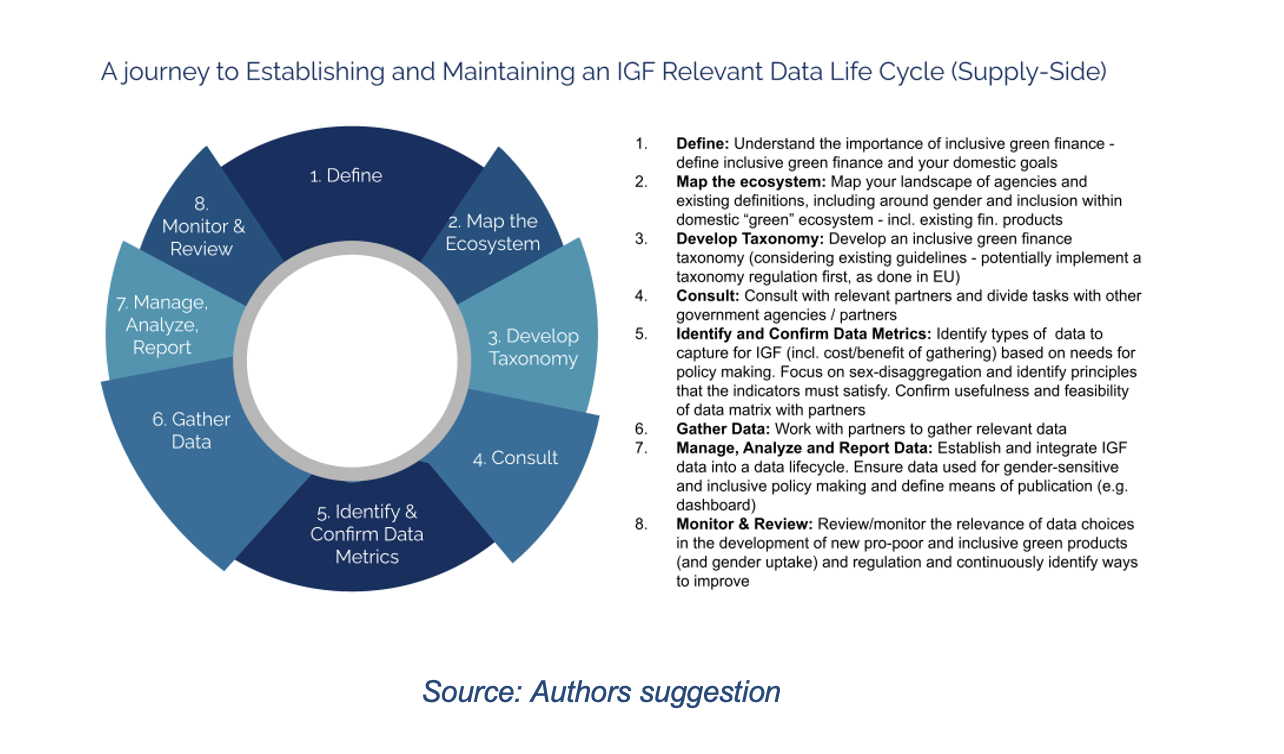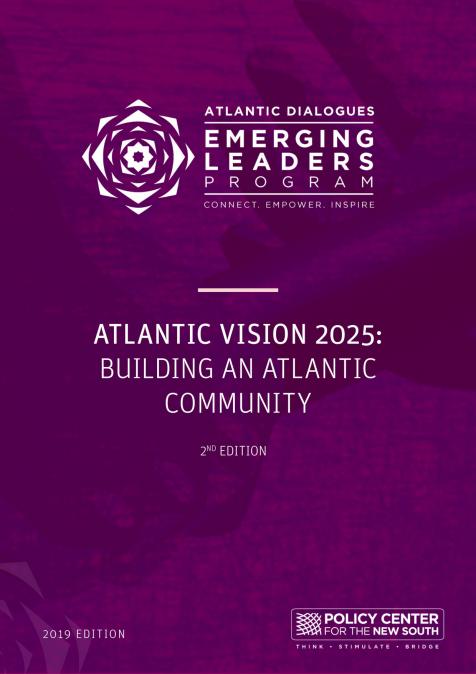Publications /
Opinion
Setting the Scene for the Current State of Inclusive Green Finance
Climate change is one of, if not the biggest, challenges facing the world. The challenge extends to banking regulators, who, in addition to other responsibilities, are now tasked with ensuring financial inclusion and climate change mitigation. However, central banks realizing how important inclusion and climate change are is only the first step. As part of this process, they need to understand how to define Inclusive Green Finance (IGF), design regulations, and determine what the focus areas should be. Accordingly, they need to develop IGF taxonomies and monitor their constituents to ensure that the financial system plays its part for a more just, climate-friendly and resilient society. While there is a growing body of knowledge available to central banks on how to improve green and inclusive practices, there are currently no guidelines on what supply-side data should be gathered by institutions to design effective regulations.
This article focuses on supply side sex-disaggregated data collection, providing an overview of existing research on the topic, gender considerations, and how these relate to developing guidelines for measurement frameworks to gather and use IGF relevant supply-side data.
Why Inclusive Finance Needs to be Made Greener
In its 2019 report, ‘A call for action; climate change as a source of financial risk’, the Network for Greening the Financial System (NGFS) made six recommendations to financial-system stakeholders to improve their roles in dealing with climate change threats. These are:
- Integrate climate-related risks into financial stability monitoring and micro-supervision;
- Integrate sustainability factors into own-portfolio management;
- Bridge the data gaps;
- Build awareness and intellectual capacity, encourage technical assistance and knowledge sharing;
- Achieve robust and internationally consistent climate and environment-related disclosure;
- Support the development of a taxonomy for economic activities.
While the NGFS report didn’t look directly at financial inclusion as part of these recommendations, it did indicate the role that data for regulators can and should play in greening financial systems.
In addition, the World Bank published a toolkit on the greening of the financial system in 2021, highlighting the role central banks should play and how the success of climate mitigation relies on high quality data for effective regulation. While progress is being made around the world in making financial systems greener, gathering representative financial inclusion data, and clarifying the financial regulators’ role, a unified approach is still lacking.
The Alliance for Financial Inclusion’s (AFI) existing guideline on demand-side data gives financial regulators and service providers a framework for the collection and use of end-customer data related to IGF. It offers step-by-step guidance for data collection (and use) from the demand side, and while this is an important first step, the effects of climate change and how to mitigate its impact is measured from both the consumer-side and the supply-side. Thus, regulators need to gather relevant supply-side data from institutions to design incentives, regulations, and recommendations, to provide better IGF products in the market.
Resources do exist for central banks on relevant topics such as data gathering, taxonomies, and the importance of developing policies targeting the bottom of the pyramid (individuals and micro, small and medium enterprises). At the cross-section of financial inclusion and green, AFI has published reports on the importance, updating, and use of data life cycles for regulators to act quicker; the changing data landscape for central banks; and data as a critical factor for decision-making in central banking.
Identifying how to integrate sex-disaggregated data is needed for more inclusive policies, regulations, and recommendations. While the subjects relevant to IGF data have been covered to some extent in literature, there is no comprehensive guide for central banks on integrating this sex-disaggregated data.
Considering the Gender Aspects of this Topic
According to the Inter-American Development Bank (IDB), a lack of sex-disaggregated data, particularly from the supply side, severely hampers financial inclusion. This impacts women more than men, as more often than not, financial services and regulations favour men. Furthermore, the World Bank’s latest data, from 2018, showed that there was still a 9% gender gap, favoring men, for financial inclusion in developing countries, specifically around access to bank accounts, which presents significant challenges for women in financial decision-making and independence. While climate change impacts everyone globally, it impacts vulnerable people, small firms, and communities the most, as they are the least resilient and are often unable to cope with extreme weather shocks caused by climate change. One of the aims in increasing financial inclusion is to ensure that the gender gap closes and that more women have access to finance, giving them greater economic opportunities and increased empowerment, particularly in relation to financial decisions and ownership. Therefore, it is important to incorporate gender considerations when central banks collect supply-side data, so the data can be employed to inform future IGF strategies and policies that are gender-sensitive.
Gender inequality in the financial sector is attributed partly to a lack of data on women and female-owned small businesses. Therefore, collecting sex-disaggregated data will be essential to ensuring equal financial inclusion for both sexes and closing the gender gap. The UN Foundation Data2X suggests that some of the challenges in gathering high-quality sex-disaggregated data in the financial sector include lack of resources, especially in developing countries, decision-makers not giving this topic a sufficiently high priority, and bias in data collection methods that fails to take into account gender considerations.
Applying a Conceptual Framework
Most developed nations distinguish between physical and transition risk transmission channels (in some cases also liability risks) to conceptualize the key areas in which green policies will fit. However, this type of conceptual framework misses the inclusive angle.
We believe that IGF needs a framework based on data sources that include two key areas: products for IGF (focus on data supply from regulated institutions) and the environmental landscape (look at data supply from non-regulated institutions), marked by the red arrows in the figure below. The mind map shows a simplified framework that highlights the importance of data coming from regulated and other institutions, thereby incorporating IGF.

This framework allows for a clear focus on the stakeholders that are most important for inclusion:
- On the individual financial services-side, women and marginalised groups, and;
- On the business side, small and medium enterprises (SMEs; including formal and informal businesses).
How to Gather Relevant Data
A recent report by the U.S. Federal Reserve Board highlighted that “financial regulators must recognise that climate change poses serious emerging risks to the U.S. financial system, and they should move urgently and decisively to measure, understand, and address these risks”. The authors suggested that the key to success is the identification and adequate use of data to design policies and regulation, as well as identifying that data is a crucial component in fighting climate change. Furthermore, the Inter-American Development Bank suggested that financial regulators need to collect supply-side data to build up a database of sex-disaggregated data that will be relevant and comparable. This will enable monitoring, evaluation, and comparison of financial inclusion for women and men, and how this can influence more inclusive financial regulations.
Below is a step-by-step diagram showing how to build taxonomies, identify relevant data to fit into existing frameworks, and provide guidance on how to gather and use the data in a gender-sensitive manner.

Existing Gaps and Challenges
To actively tackle issues of climate change and financial inclusion, regulators need to gather the correct data. Some of the relevant data has been identified (e.g. a dashboard on scaling up green finance from NGFS), but given the novelty of the subject, not all sources and data used are clear in the fight against climate change. Adding the subject of inclusion to the discussion adds complexity, but also helps narrow down the scope of relevant data. There is an opportunity to identify specific data from regulated and other institutions that may be collected and analyzed for regulation, policymaking and drafting recommendations.
Some countries have made progress in designing and using inclusive or green financial data. For example, Costa Rica has set up a financial inclusion index, and Nepal has developed environmental and social risk management guidelines for the financial sector. These initiatives help financial institutions evaluate the environmental and social risks that could arise from transactions with their clients, and take measures to mitigate those risks. While some initial findings show the collection of supply-side data on green topics from the central banks around the world, such as from Brazil and Bangladesh, there are no current initiatives that establish what data to gather and how to use it. It is also not clear what agencies and institutions should be involved in providing relevant data for the central banks, which also use information from credit-rating agencies and specific ESG (environmental, social and governance) data providers. Yet, there is limited policy experience on what the role of these different actors should play in cooperation with the central banks.
Hence, there remain plenty of knowledge gaps on the framework for data collection (as referenced above), which data to gather, and how to effectively use it. But as always, there is plenty of opportunity to improve this area to ensure it becomes more inclusive and relevant.
(*) Morten Seja is an alumnus of the Atlantic Dialogues Emerging Leaders Program 2014.





